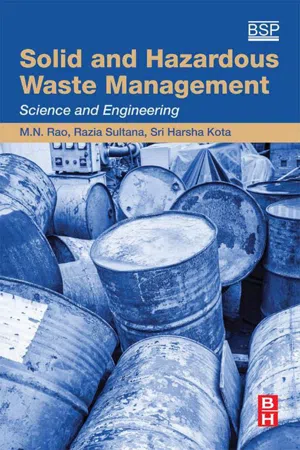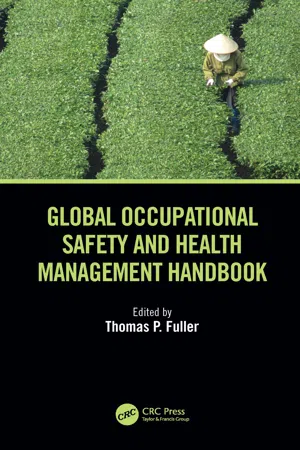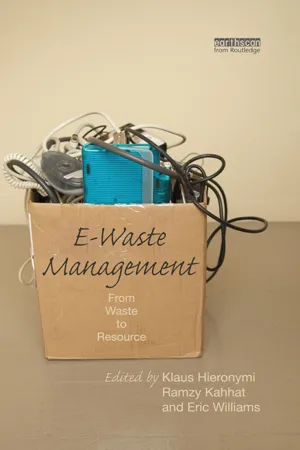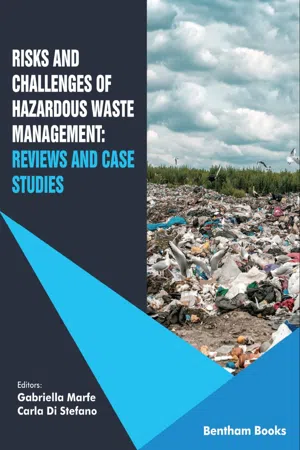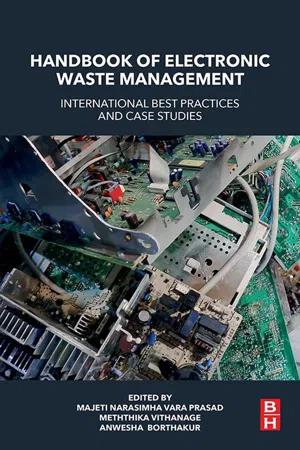E Waste
E-waste refers to electronic products that have reached the end of their useful life and are discarded. This includes items like computers, mobile phones, and other electronic devices. E-waste poses environmental and health risks due to the presence of hazardous materials, and proper disposal and recycling are essential to mitigate these impacts.
7 Key excerpts on "E Waste"
- eBook - ePub
Solid and Hazardous Waste Management
Science and Engineering
- M.N. Rao, Razia Sultana, Sri Harsha Kota(Authors)
- 2016(Publication Date)
- Butterworth-Heinemann(Publisher)
...However, technically, e-waste is only a subset of WEEE. According to the Organization for Economic Cooperation and Development (OECD) any appliance using an electric power supply that has reached its end-of-life would come under WEEE. Globally, WEEE/e-waste is the most commonly used terms for e-waste. There is no standard definition of WEEE/e-waste. A number of countries have come out with their own definitions, interpretations, and usage of the term e-waste/WEEE. The term e-waste refers to the technological characteristics and the hazardous materials incorporated in this waste. It refers to a broad range of electric and electronic goods that have outlived their use for producers and consumers, are ready for disposal, and that contain chemical materials considered hazardous for humans and for our natural environment. The software sector of the information technology industry has led to a prominent global presence of India. Policy changes have led to a tremendous influx of leading multinational companies into India to set up manufacturing facilities, research and development centers, and software development facilities. The domestic market is getting revitalized due to buoyant economic growth and changing consumption patterns. This growth has significant economic and social impacts. The increase of electronic products, consumption rates, and higher obsolescence rate leads to higher generation of e-waste. The increasing obsolescence rates of electronic products added to the huge import of junk electronics from abroad create a complex scenario for solid waste management in India. Among the electronic items, computers, televisions, and mobile phones are finding their way into thE Waste stream...
- Biswaranjan Acharya, Satarupa Dey, Mohammed Zidan, Biswaranjan Acharya, Satarupa Dey, Mohammed Zidan(Authors)
- 2022(Publication Date)
- CRC Press(Publisher)
...Consumer eagerness for new advanced products forces a decrease in the lifespan of existing products, and as a result it increases electrical and electronic waste. An ever-growing portion of the solid waste from cities is due to the increase of e-waste at an accelerated rate [ 6 – 8 ]. Electronic items after use are shipped over oceans, which creates a complicated waste matter consisting of several harmful metals and chemical substances. Consumption of electronic products in India is very high due to the large population. 1.2 What Is E-Waste? Waste products from electricals and electronics that have been discarded or where the lifespan of the item has ended are known as electronic waste (e-waste). This includes devices that are operated by either electricity or batteries, and includes devices that are thrown away to landfill or given to a reseller organization. Table 1.1 depicts the distribution of e-waste items in different categories [ 9 ]. TABLE 1.1 Distribution of E-Waste Items Home Appliances Communication and IT Devices Entertainment Devices Electronic Items Office and Medical Equipment Microwaves Home entertainment devices Electric cookers Heaters Fans Cell phones Smart phones Computer accessories Bluetooth Music systems Televisions Xbox consoles Treadmills Various electronics equipment Copiers/printers Autoclave Shredding machines Fax machines X-ray equipment Power supplies UPS systems Power distribution systems (PDUs) E-waste contains toxins which produce greenhouse gases (GHGs) at the. time of their disposal and which impact human health and effect pollution due to low levels of processing. The more the e-waste in landfill, the more these poisonous materials mix into groundwater...
- Thomas P. Fuller, Thomas P. Fuller(Authors)
- 2019(Publication Date)
- CRC Press(Publisher)
...12 Global Issues and Aspects of the Disposal and Recycling of Electronics Thomas P. Fuller Illinois State University Contents 12.1 Introduction 12.2 Regional and National Disposal/Recycling Processes 12.2.1 West (North America) 12.2.2 East (Asia, Middle East, Australia) 12.2.3 Africa, Australia, and Europe 12.3 Problems and Issues with Existing Systems of E-Waste Handling and Disposal 12.3.1 Environmental Hazards 12.3.2 Occupational Hazards 12.4 Laws and Regulations 12.5 Conclusions/Recommendations References 12.1 Introduction E-waste, also known as electronic waste or electrical waste, has been defined as “Waste Electrical and Electronic Equipment (WEEE) that is dependent on electric currents or electromagnetic fields in order to function.” This includes all components, subassemblies, and consumables that are part of the original equipment at the time of disposal. E-waste includes cell phones, fax machines, air conditioners, televisions, batteries, computers, laptops, washing machines, refrigerators, and any other major appliances and electrical or electronic equipment (EEE) (Brune, 2013). The United States and China top the list of the major contributors of waste. The annual global production of e-waste reached 48.9 million metric tons in 2012 and is expected to exceed 50 million metric tons in 2018 (StEP, 2014; Baldé, 2015; Seeberger, 2016). The amount of e-waste globally is growing at an alarming rate with no foreseeable end. WEEE has been estimated to comprise up to 8% of all municipal waste (Widmer, 2005). Rapid technological innovation and changes in lifestyle drive the electronic industry to continually reveal new products to consumers (Annamalai, 2015). In addition to consumer sources, every office, manufacturing facility, hospital, and service business contribute to the EEE Waste supply chain. The composition of e-waste is varied and is based on the type of electronic device. Even within the same types of electronics, variations in composition can occur...
- eBook - ePub
E-Waste Management
From Waste to Resource
- Klaus Hieronymi, Ramzy Kahhat, Eric Williams, Klaus Hieronymi, Ramzy Kahhat, Eric Williams(Authors)
- 2012(Publication Date)
- Routledge(Publisher)
...1 ELECTRONIC WASTE Environment and Society Ramzy Kahhat DEPARTMENT OF ENGINEERING, PONTIFICIA UNIVERSIDAD CATÓLICA DEL PERÚ 1.1 Introduction Electronics equipment significantly influences the way societies relate, and it is impossible to ignore the vast positive impacts of electronics use by society. Nevertheless, important concerns also exist related to the flow of electronics deemed obsolete by consumers (e.g. households, corporations, public agencies, schools) all over the world. These concerns intensify as the manufacturing and adoption rate, triggered by technological development of these devices, increases around the world. For example, the number of mobile phones per capita in the United States and China increased 139% and 725% from 2000 to 2009, respectively (1). Compared to expenditures on product development, marketing, and sales, a smaller amount of resources has been devoted to the end-of-use management of electronic equipment, such as reuse, recycling, and landfilling. In the last two decades, some countries and regions have focused on the management of this complex waste stream. The oldest and probably most successful electronic waste (e-waste) or waste electrical and electronic equipment (WEEE) system is the one found in Switzerland, with recycling rates of approximately 9.8 kg of e-waste per person per year (2). SWICO (Swiss Association for Information, Communication and Organization Technology) and SENS (Swiss Foundation for Waste Management), the two e-waste systems in the country, collect and recycle a vast portfolio of electronics, including information technology (IT) and office equipment products (SWICO) and home appliances (SENS) (2, 3). Moreover, with the implementation of the WEEE Directive and under the principle of extended producer responsibility (EPR), the members of the European Union (EU) have been adopting regulations to properly manage e-waste (4)...
- eBook - ePub
Waste
A Handbook for Management
- Trevor Letcher, Daniel A. Vallero(Authors)
- 2019(Publication Date)
- Academic Press(Publisher)
...Nevertheless, these products do not come without reserve: although the production of high-tech equipment is often associated with sterile laboratories, the equipment very often contains significant amounts of extremely scarce, sometimes hazardous and very often valuable, material. Furthermore in operation mode, electrical and electronic equipment consumes energy which might very well come from fossil and other nonsustainable sources. At the “end-of-life,” much of thE Waste from these products is neither collected nor appropriately treated, which results in environmental pollution and a loss of vital metals and possibly health hazards in one form or another. There is a wide gulf between our enjoyment of modern technological equipment and the sustainable use of the precious elements and materials that make up the equipment. This article is mainly concerned with the end-of-life stage of electrical and electronic equipment (EEE): the so-called E-waste. No attempt has been made to include details of the treatment of E-waste that can be found in Ref. [1]. 2 What Is E-Waste? Legal and policy texts around the globe have introduced hundreds of definitions of E-waste in order to assign responsibilities linked to the necessary financing of “take-back” schemes and the financing of recovery treatment processes. The motivation behind some of the definitions becomes obvious when certain electrical components are not included, such as E-waste from the automotive industry. This is unrealistic as the only difference between the automotive E-waste and other electrical equipment waste is that the automotive E-waste is a component in an automobile...
- Gabriella Marfe, Carla Di Stefano(Authors)
- 2020(Publication Date)
- Bentham Science Publishers(Publisher)
...Examples of E-waste recycling sites are shown in Fig. (1). Fig. (1)) E-waste recycling sites. HEALTH THREATS AND ENVIRONMENTAL CONCERNS As indicated by the Ministry of Environment and Forests, there are about twenty-eight active Storage, Treatment, and Disposal Facilities (STDFs) for dangerous waste administration in the country. The rising personal satisfaction and high paces of asset utilisation examples have had an inadvertent and antagonistic effect on the earth. In addition to the weight of administration of dangerous civil waste, the administration of gigantic and developing E-wastes is rising as one of the most significant natural issues of developing countries, particularly India. Around three hundred thousand tonnes of E-waste were created in India in 2018. With the forecast that about one million tonnes of E-wastes will be created, India's situation in this way faces a genuine danger. The issues related to E-waste are currently being perceived. E-waste is profoundly mind-boggling to deal with because of its structure. It contains various segments containing harmful elements that adversely affect human health if not taken care of appropriately. Frequently, these issues emerge out due to inappropriate reusing and transfer methods [ 14, 15 ]. The Effect of Dangerous Materials on the Environment and Health Toxins in E-waste are ordinarily packed in-circuit sheets, plastics, batteries, and LCDs (Liquid crystal displays). Most of the electronic goods contain a huge amount of dangerous metals and synthetic concoctions like mercury, which is as of now being abolished in different countries. Mercury is versatile and toxic in any structure - inorganic, natural or basic. It can produce sorrow and self-destructive propensities and cause loss of motion, Alzheimer's ailment, speech and vision weakness, sensitivities, hypospermia, and feebleness...
- eBook - ePub
Handbook of Electronic Waste Management
International Best Practices and Case Studies
- Majeti Narasimha Var Prasad, Meththika Vithanage, Anwesha Borthakur(Authors)
- 2019(Publication Date)
- Butterworth-Heinemann(Publisher)
...These facts elaborate that the E-waste is one of the fastest growing and most complex types of solid wastes in this rapid growing economies (Bob et al., 2017). The types of substances in E-waste can be categorized into two major categories according to their toxicity: hazardous and nonhazardous. Most of heavy metals, in particular, Cd, Cr, Pb and Hg, chlorofluorocarbon, polycyclic aromatic hydrocarbons (PAHs), polybrominated diphenyl ethers (PBDEs), polychlorinated biphenyls (PCBs), and polychlorinated dibenzo- p -dioxin furans (PCDD/Fs) are some of the groups that fall into hazardous category. All of these compounds are able to affect the quality of the ecosystem and the improper E-waste handling is the foremost reason to these detrimental effects. There are various techniques that is being used regarding informal E-waste recycling techniques including gold recovery from printed circuit boards with cyanide salt leaching or nitric acid and mercury amalgamation, open burning of printed circuit boards that cables for component separation or for solder recovery, heating and acid leaching of printed circuit boards, toner sweeping, plastic chipping, and melting, burning of wires to recover copper, and manual dismantling of cathode ray tubes, and open burning of plastics (Song and Li, 2014). All of these nonsafe methods are able to generate harmful consequences on environment and human community. During dismantling processes, for instance, dioxins, persistent organic pollutants, PAHs, PCBs, persistent halogenated compounds, hexavalent chromium, PBDEs, and heavy metals are been released and these pollutants persist in the environment for long period of time (Orlins and Guan, 2016). 5.2 Impacts of E-waste on ecosystem health The impact of E-waste is not limited for a recycling or dumping site and it extends beyond the processing sites creating possible adverse impacts to the whole ecosystem: soil, water, air, and other biota...
